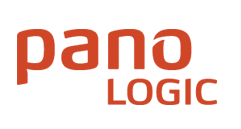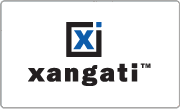
In computer networking, a thin client is a simple (low-performance) computer that has been optimized for establishing a remote connection with a server-based computing environment. The server does most of the work, which can include launching software programs, performing calculations, and storing data. This contrasts with a rich client or a conventional personal computer; the former is also intended for working in a client–server model but has significant local processing power, while the latter aims to perform its function mostly locally.
A virtual storage area network is a logical representation of a physical storage area network (SAN). A VSAN abstracts the storage-related operations from the physical storage layer, and provides shared storage access to the applications and virtual machines by combining the servers' local storage over a network into a single or multiple storage pools.
Application virtualization is a software technology that encapsulates computer programs from the underlying operating system on which they are executed. A fully virtualized application is not installed in the traditional sense, although it is still executed as if it were. The application behaves at runtime like it is directly interfacing with the original operating system and all the resources managed by it, but can be isolated or sandboxed to varying degrees.
The following is a timeline of virtualization development. In computing, virtualization is the use of a computer to simulate another computer. Through virtualization, a host simulates a guest by exposing virtual hardware devices, which may be done through software or by allowing access to a physical device connected to the machine.
Desktop virtualization is a software technology that separates the desktop environment and associated application software from the physical client device that is used to access it.

VMware ESXi is an enterprise-class, type-1 hypervisor developed by VMware for deploying and serving virtual computers. As a type-1 hypervisor, ESXi is not a software application that is installed on an operating system (OS); instead, it includes and integrates vital OS components, such as a kernel.

Oracle VM VirtualBox is a type-2 hypervisor for x86 virtualization developed by Oracle Corporation.

In computing, the term remote desktop refers to a software- or operating system feature that allows a personal computer's desktop environment to be run remotely off of one system, while being displayed on a separate client device. Remote desktop applications have varying features. Some allow attaching to an existing user's session and "remote controlling", either displaying the remote control session or blanking the screen. Taking over a desktop remotely is a form of remote administration.

Pano Logic was a manufacturer of devices which present virtual desktops to the end user with no local processing power. They describe this concept as "zero client". This is perceived as offering benefits in end-user support and in power provision to desks. OEM versions have been included in displays from some vendors, allowing a single unit to be deployed. The company failed in October 2012. In March 2013, Propalms announced they had acquired the rights to support Panologic customers, and will "help transition the customer base to a new platform".
In computing, virtualization or virtualisation is the act of creating a virtual version of something, including virtual computer hardware platforms, storage devices, and computer network resources.

IGEL Technology is a German multinational software company best known for their "Next generation edge operating system" which is purpose-built for secure access to cloud workspaces such as Virtual Desktop Infrastructure (VDI) and/or Desktop as a Service.
VMware Horizon is a commercial desktop and app virtualization product developed by VMware, Inc for Microsoft Windows, Linux and macOS operating systems. It was first sold under the name VMware VDM, but with the release of version 3.0.0 in 2008 it was changed to "VMware View". The name was updated to "Horizon View" with the launch of version 6 in April 2014 and is now referred to as "VMware Horizon" to represent desktop and app virtualization.
A hosted desktop is a product set within the larger cloud-computing sphere generally delivered using a combination of technologies including hardware virtualization and some form of remote connection software, Citrix XenApp or Microsoft Remote Desktop Services being two of the most common. Processing takes place within the provider's datacentre environment with traffic between the datacentre and the client being primarily : display updates, mouse movements and keyboard activity.
Leostream, founded in 2002, is a privately held technology company based in Waltham, Massachusetts. Its flagship product is a connection broker for virtual desktop infrastructure (VDI) and resources hosted in the datacenter.
XenClient is a desktop virtualization solution from Citrix that runs secure virtual desktops on endpoint devices. Desktops are run locally, without hosting applications or the operating system in a datacenter. It consists of a Type-1 Xen client hypervisor and a management server, which provides features such as centralized provisioning, patching, updating, monitoring, policy controls, and de-provisioning. It enforces security through features including AES-256 full disk encryption, VM isolation, remote kill, lockout, USB filtering, and VLAN tagging. XenClient supports use cases such as disconnected operation on laptops, limited connectivity environments, and other use cases where use of local execution is desired and centralized management is required.
Virsto develops a VM-centric storage hypervisor. The company is privately funded and headquartered in Sunnyvale, California. On February 11, 2013, VMware announced that it had signed a definitive agreement to acquire Virsto.
Founded by Alex Vasilevsky, Virtual Computer is a venture-backed software company in the Boston area that produces desktop virtualization products, which combine centralized management with local execution on a hypervisor running on PCs. Virtual Computer has developed a type-1 hypervisor that runs directly on end-user PCs, delivering native PC performance and mobility. By running the workload on the PC, Virtual Computer enables companies to have centralized management without servers, storage, and networking required for server-hosted VDI. The technology supports shared image management, enabling an IT professional to manage thousands of desktops and laptops the same way that they would manage one.
HP ConvergedSystem is a portfolio of system-based products from Hewlett-Packard (HP) that integrates preconfigured IT components into systems for virtualization, cloud computing, big data, collaboration, converged management, and client virtualization. Composed of servers, storage, networking, and integrated software and services, the systems are designed to address the cost and complexity of data center operations and maintenance by pulling the IT components together into a single resource pool so they are easier to manage and faster to deploy. Where previously it would take three to six months from the time of order to get a system up and running, it now reportedly takes as few as 20 days with the HP ConvergedSystem.

Xangati, Inc is an American-based private company, that provides service assurance analytics software for enterprises and service providers, operating in virtualized data centers and hybrid cloud environments.
Ericom Connect is a remote access/application publishing solution produced by Ericom Software that provides secure, centrally managed access to physical or hosted desktops and applications running on Microsoft Windows and Linux systems.





